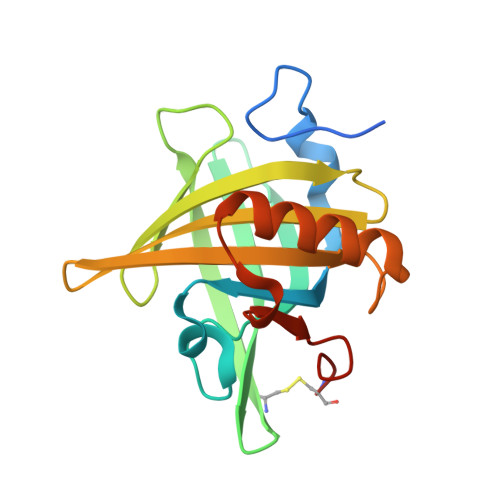Van der Waals Interactions Dominate Ligand-Protein Association in a Protein Binding Site Occluded from Solvent Water
Barratt, E., Bingham, R.J., Warner, D.J., Laughton, C.A., Phillips, S.E.V., Homans, S.W.(2005) J Am Chem Soc 127: 11827-11834
- PubMed: 16104761
- DOI: https://doi.org/10.1021/ja0527525
- Primary Citation of Related Structures:
1YP6, 1YP7 - PubMed Abstract:
In the present study we examine the enthalpy of binding of 2-methoxy-3-isobutylpyrazine (IBMP) to the mouse major urinary protein (MUP), using a combination of isothermal titration calorimetry (ITC), NMR, X-ray crystallography, all-atom molecular dynamics simulations, and site-directed mutagenesis. Global thermodynamics data derived from ITC indicate that binding is driven by favorable enthalpic contributions, rather than a classical entropy-driven signature that might be expected given that the binding pocket of MUP-1 is very hydrophobic. The only ligand-protein hydrogen bond is formed between the side-chain hydroxyl of Tyr120 and the ring nitrogen of the ligand in the wild-type protein. ITC measurements on the binding of IBMP to the Y120F mutant demonstrate a reduced enthalpy of binding, but nonetheless binding is still enthalpy dominated. A combination of solvent isotopic substitution ITC measurements and all-atom molecular dynamics simulations with explicit inclusion of solvent water suggests that solvation is not a major contributor to the overall binding enthalpy. Moreover, hydrogen/deuterium exchange measurements suggest that there is no significant contribution to the enthalpy of binding derived from "tightening" of the protein structure. Data are consistent with binding thermodynamics dominated by favorable dispersion interactions, arising from the inequality of solvent-solute dispersion interactions before complexation versus solute-solute dispersion interactions after complexation, by virtue of poor solvation of the binding pocket.
Organizational Affiliation:
Astbury Centre for Structural Molecular Biology, School of Biochemistry & Microbiology, University of Leeds, Leeds LS2 9JT, UK.

















